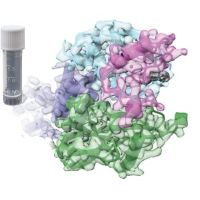Specification
| Description | Recombinant protein from the full-length sequence of Homo sapiens ubiquilin 1 (UBQLN1), transcript variant 1 (NM_013438). |
| Organism | Homo sapiens (Human) |
| Expression Host | Human Cells |
| Tag Info | His or DYKDDDDK. Please contact us if you need further information or require specific designed tag. |
| Purity | Greater than 90% by SDS-PAGE gel |
| Uniprot ID | Q9UMX0 |
| Entry Name | UBQL1_HUMAN |
| Gene Names | UBQLN1 DA41 PLIC1 |
| Alternative Gene Names | DA41 PLIC1 |
| Alternative Protein Names | Ubiquilin-1 (Protein linking IAP with cytoskeleton 1) (PLIC-1) (hPLIC-1) |
| Application | Antigens, Western, ELISA and other in vitro binding or in vivo functional assays, and protein-protein interaction studies; For research & development use only! |
| Buffer | Purified protein formulated in a sterile solution of PBS buffer, pH7.2, without any preservatives |
| Endotoxin | Endotoxin level is < 0.1 ng/µg of protein (<1EU /µg) |
| Length | 589 |
| Molecular Weight(Da) | 62519 |
| Protein Sequence | (The sequence of expressed protein may have some variation from the sequence shown below. Please contact us for the exact sequence.) MAESGESGGPPGSQDSAAGAEGAGAPAAAASAEPKIMKVTVKTPKEKEEFAVPENSSVQQFKEEISKRFKSHTDQLVLIFAGKILKDQDTLSQHGIHDGLTVHLVIKTQNRPQDHSAQQTNTAGSNVTTSSTPNSNSTSGSATSNPFGLGGLGGLAGLSSLGLNTTNFSELQSQMQRQLLSNPEMMVQIMENPFVQSMLSNPDLMRQLIMANPQMQQLIQRNPEISHMLNNPDIMRQTLELARNPAMMQEMMRNQDRALSNLESIPGGYNALRRMYTDIQEPMLSAAQEQFGGNPFASLVSNTSSGEGSQPSRTENRDPLPNPWAPQTSQSSSASSGTASTVGGTTGSTASGTSGQSTTAPNLVPGVGASMFNTPGMQSLLQQITENPQLMQNMLSAPYMRSMMQSLSQNPDLAAQMMLNNPLFAGNPQLQEQMRQQLPTFLQQMQNPDTLSAMSNPRAMQALLQIQQGLQTLATEAPGLIPGFTPGLGALGSTGGSSGTNGSNATPSENTSPTAGTTEPGHQQFIQQMLQALAGVNPQLQNPEVRFQQQLEQLSAMGFLNREANLQALIATGGDINAAIERLLGSQPS |
Background
| Function | FUNCTION: Plays an important role in the regulation of different protein degradation mechanisms and pathways including ubiquitin-proteasome system (UPS), autophagy and endoplasmic reticulum-associated protein degradation (ERAD) pathway. Mediates the proteasomal targeting of misfolded or accumulated proteins for degradation by binding (via UBA domain) to their polyubiquitin chains and by interacting (via ubiquitin-like domain) with the subunits of the proteasome (PubMed:15147878). Plays a role in the ERAD pathway via its interaction with ER-localized proteins UBXN4, VCP and HERPUD1 and may form a link between the polyubiquitinated ERAD substrates and the proteasome (PubMed:19822669, PubMed:18307982). Isoform 1, isoform 2 and isoform 3 play a role in unfolded protein response (UPR) by attenuating the induction of UPR-inducible genes, DDTI3/CHOP, HSPA5 and PDIA2 during ER stress (PubMed:18953672). Involved in the regulation of macroautophagy and autophagosome formation; required for maturation of autophagy-related protein LC3 from the cytosolic form LC3-I to the membrane-bound form LC3-II and may assist in the maturation of autophagosomes to autolysosomes by mediating autophagosome-lysosome fusion (PubMed:19148225, PubMed:20529957, PubMed:23459205). Negatively regulates the TICAM1/TRIF-dependent toll-like receptor signaling pathway by decreasing the abundance of TICAM1 via the autophagic pathway (PubMed:21695056). Isoform 1 and isoform 3 play a key role in the regulation of the levels of PSEN1 by targeting its accumulation to aggresomes which may then be removed from cells by autophagocytosis (PubMed:21143716). Promotes the ubiquitination and lysosomal degradation of ORAI1, consequently downregulating the ORAI1-mediated Ca2+ mobilization (PubMed:23307288). Suppresses the maturation and proteasomal degradation of amyloid beta A4 protein (A4) by stimulating the lysine 63 (K63)-linked polyubiquitination. Delays the maturation of A4 by sequestering it in the Golgi apparatus and preventing its transport to the cell surface for subsequent processing (By similarity). {ECO:0000250|UniProtKB:Q9JJP9, ECO:0000269|PubMed:18307982, ECO:0000269|PubMed:18953672, ECO:0000269|PubMed:19148225, ECO:0000269|PubMed:19822669, ECO:0000269|PubMed:20529957, ECO:0000269|PubMed:21143716, ECO:0000269|PubMed:21695056, ECO:0000269|PubMed:23307288, ECO:0000269|PubMed:23459205, ECO:0000303|PubMed:15147878}. |
| Pathway | |
| Protein Families | |
| Tissue Specificity | Brain (at protein level) (PubMed:18953672). Ubiquitous. Highly expressed throughout the brain; detected in neurons and in neuropathological lesions, such as neurofibrillary tangles and Lewy bodies. Highly expressed in heart, placenta, pancreas, lung, liver, skeletal muscle and kidney. {ECO:0000269|PubMed:11076969, ECO:0000269|PubMed:11853878, ECO:0000269|PubMed:18953672}. |
QC Data
| Note | Please contact us for QC Data |
| Product Image (Reference Only) |  |

